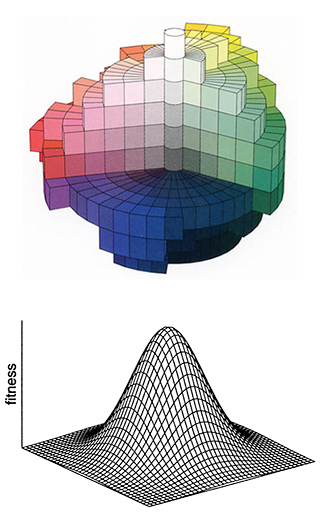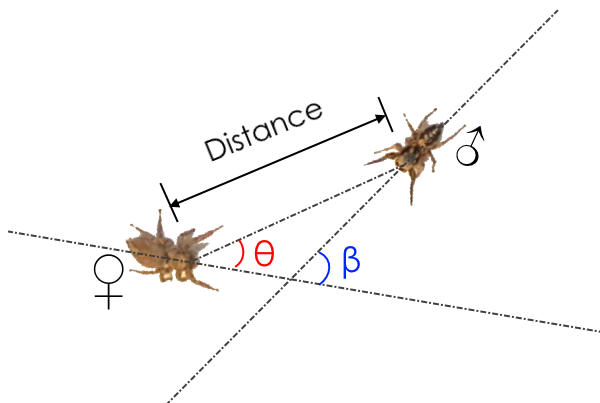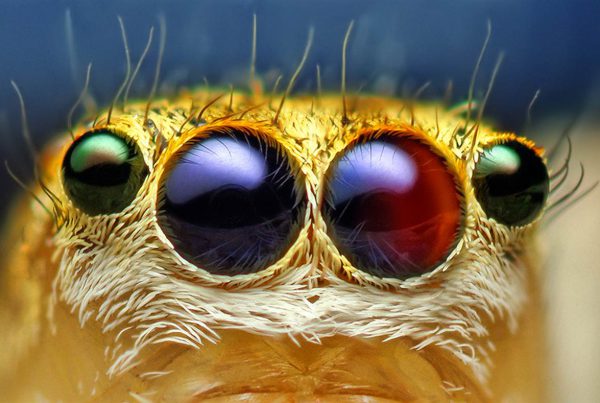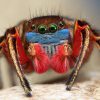BOLD = lab members, **undergraduate authors
2021
Robledo-Ospina, L.E., Morehouse, N.I., Escobar, F., Falcón-Brindis, A., Jiménez, M.L., Rao, D. 2021. Prey colour biases of araneophagic mud-daubing wasps. Animal Behaviour, 172:25-33. PDF
LeCroy, K.A., Arceo-Gómez, G., Koski, M.H., Morehouse, N.I., and Ashman, T.-L. 2021. Floral color properties of serpentine seep assemblages depend on community size and species richness. Frontiers in Plant Science, 11:2107. PDF
2020
Morehouse, N.I. 2020. Spider vision. Current Biology, 30:R963-983. PDF
Ren, A., Day, C.R., Hanly, J.J., Counterman, B.A., Morehouse, N.I., and Martin, A. 2020. Convergent evolution of broadband reflectors underlies metallic coloration in butterflies. Frontiers in Ecology and Evolution, 8:206. PDF
Morehouse, N.I., Raubenheimer, D., Kay, A., and Bertram, S.M. 2020. Integrating nutritional and behavioral ecology: Mutual benefits and new frontiers. Advances in the Study of Behavior, 52:29-63. PDF
2019
Plakke, M.S., Walker, J.L., Lombardo, J.B.**, Goetz, B.J.**, Pacella, G.N.**, Durrant, J.D., Clark, N.L., and Morehouse, N.I. 2019. Characterization of female reproductive proteases in a butterfly from functional and evolutionary perspectives. Physiological and Biochemical Zoology, 92(6):579-590. PDF
Hill, J.A., Rastas, P., Hornett, E.A., Neethiraj, R., Clark, N., Morehouse, N.I., de la Paz Celorio-Mancera, M., Cols, J.C., Dircksen, H., Meslin, C., Keehnen, N., Pruisscher, P., Sikkink, K., Vives, M., Vogel, H., Wiklund, C., Woronik, A., Boggs, C., Nylin, S., Wheat, C. 2019. Unprecedented reorganization of holocentric chromosomes provides insights into the enigma of lepidopteran chromosome evolution. Science Advances, 5(6):eaau3648. PDF
Goté, J.T.**, Butler, P.M., Zurek, D.B., Buschbeck, E.K., and Morehouse, N.I. 2019. Growing tiny eyes: How juvenile jumping spiders retain high visual performance in the face of size limitations and developmental constraints. Vision Research, 160:24-36. PDF
Press coverage: Scientific American, UC Magazine, Mother Nature Network, ZME Science
Morehouse, N.I. and Outomuro, D. 2019. Visual signals using incident light. Encyclopedia of Animal Behavior, 2nd Ed. Editor-in-Chief: Jae Choe, Elsevier, Academic Press, 1:500-507. PDF
2018
Nallu, S., Hill, J., Don, K., Sahagun, C., Zhang, W., Meslin, C., Snell-Rood, E., Clark, N.L., Morehouse, N.I., Bergelson, J., Wheat, C.W., and Kronforst, M.R. 2018. The molecular genetic basis of herbivory between butterflies and their host-plants. Nature Ecology & Evolution, 2:1418-1427. PDF
Press coverage: Nature Plants, Nature Ecology & Evolution Blog
Sandre, S-L., Kaart, T., Morehouse, N.I., Tammaru, T. 2018. Weak and inconsistent associations between melanic darkness and fitness related traits in an insect. Journal of Evolutionary Biology, 31(12):1959-1968. PDF
McQueen, E.W. and Morehouse, N.I. 2018. Rapid divergence of pheromone profiles between subspecies of the butterfly Pieris rapae. Journal of Insect Science, 18(2):33. PDF
2017
Meslin, C., Cherwin, T.S.**, Plakke, M.S., Small, B.S.**, Goetz, B.J.**, Morehouse, N.I., and Clark, N.L. 2017. Structural complexity and molecular heterogeneity of a butterfly ejaculate reflect a complex history of selection. Proceedings of the National Academy of Sciences, 114(27),E5406-E5413. PDF
Press coverage: Science, The Atlantic, Newsweek, New York Post, I F-ing Love Science, UC Magazine, BioTechniques, Axios, Science Daily
Echeverri, S.A., Morehouse, N.I., and Zurek, D.B. 2017. Control of signaling alignment during the dynamic courtship display of a jumping spider. Behavioral Ecology. PDF
Press coverage: Popular Science
Morehouse, N.I., Buschbeck, E.K., Zurek, D.B., Steck, M., and Porter, M.L. 2017. Molecular evolution of spider vision: New opportunities, familiar players. Biological Bulletin. PDF
2016
Limeri, L.B., and Morehouse, N.I. 2016. The evolutionary history of the ‘alba’ polymorphism in the butterfly sub-family Coliadinae (Lepidoptera: Pieridae). Biological Journal of the Linnean Society, 117(4),716-724. PDF, Supplemental Material
Taylor, L.A., Amin, Z.**, Maier, E.B.**, Byrne, K.J.**, and Morehouse, N.I. 2016. Flexible color-learning in an invertebrate predator: Habronattus jumping spiders can learn to prefer or avoid the color red when foraging. Behavioral Ecology, 27(2),520-529. PDF
2015
Zurek, D.B., Cronin, T.W., Taylor, L.A., Byrne, K.**, Sullivan, M., and Morehouse, N.I. 2015. Spectral filtering enables trichromatic vision in colorful jumping spiders. Current Biology, 25(10), R403-R404. PDF
- Press coverage: National Geographic, Science, Smithsonian, LA Times, ScienceDaily, Science World Report, EurekaAlert!, Spiegel Online (German), Neue Zürcher Zeitung (German), Die Welt (German), 人民网 (Chinese), N+1 (Russian), SINC (Spanish), Vozpópuli (Spanish), n-tv (German), The Scientist, I F-ing Love Science, Examiner.com, NYC Today, Phys.org, Digital Journal, Futurity, Sci-News, redOrbit, Pitt News
Plakke, M.S., Deutsch, A.B.**, Meslin, C., Clark, N.L. and Morehouse, N.I. 2015. Dynamic digestive physiology of a female reproductive organ in a polyandrous butterfly. Journal of Experimental Biology, 218, 1548-1555. PDF
Snell-Rood, E., Cothran, R., Espeset, A., Jeyasingh, P., Hobbie, S. and Morehouse, N.I. 2015. Life history evolution in the anthropocene: Effects of increasing nutrients on traits and tradeoffs. Evolutionary Applications. PDF
Meslin, C., Plakke, M.S, Deutsch, A.B.**, Small, B.S.**, Morehouse, N.I., and Clark, N.L. 2015. Digestive organ in the female reproductive tract borrows genes from multiple organ systems to adopt critical functions. Molecular Biology and Evolution, 32(6), 1567-1580. PDF, Supplemental Material
2014
Morehouse, N.I. 2014. Condition-dependent ornaments, life histories, and the evolving architecture of resource-use. Integrative and Comparative Biology, 54(4), 591-600. PDF
Limeri, L.B. and Morehouse, N.I. 2014. Sensory biases and the maintenance of color polymorphisms: Viewing the Colias ‘alba’ polymorphism through the male visual system. Functional Ecology, 28(5), 1197-1207. PDF
Ligon, R.A., Dolezal, A.G., Hicks, M.R., Butler, M.W., Morehouse, N.I. and Ganesh, T.G. 2014. Using ants, animal behavior, and the learning cycle to investigate scientific processes. American Biology Teacher, 76, 52-534. PDF
Taylor, L.A., Maier, E.B.**, Byrne, K.J.**, Amin, Z.** and Morehouse, N.I. 2014. Colour use by tiny predators: Jumping spiders show colour biases during foraging. Animal Behaviour, 90, 149-157. PDF
2013
Hua, J., Morehouse, N.I. and Relyea, R. 2013. Pesticide resistance in amphibians: Induced resistance in susceptible populations, constitutive tolerance in tolerant populations. Evolutionary Applications, 6(7), 1028-1040. PDF
Morehouse, N.I., Mandon, N., Christides, J.P., Body, M., Bimbard, G. and Casas, J. 2013. Seasonal selection and resource dynamics in a seasonally polyphenic butterfly. Journal of Evolutionary Biology, 26, 175-185. PDF
2011
Meadows, M.G., Morehouse, N.I., Rutowski, R.L, Douglas, J.M. and McGraw, K.J. 2011. Quantifying iridescent coloration in animals: A method for improving repeatability. Behavioral Ecology and Sociobiology. 65(6), 1317-1327. PDF
Van Gossum, H., Bots, J, Van Heusden, J, Hammers, M., Katleen, H. and Morehouse, N.I. 2011. Reflectance spectra and morph mating frequencies support intraspecific mimicry in the female colour polymorphic damselfly Ischnura elegans. Evolutionary Ecology. 25(1), 139-154. PDF
2010
Morehouse, N.I. and Rutowski, R.L. 2010. In the eyes of the beholders: Female choice and avian predation risk associated with an exaggerated male butterfly color. American Naturalist, 176(6), 768-784. PDF
Morehouse, N.I., Nakazawa, T., Booher, C.M., Jeyasingh, P.D. and Hall, M.D. 2010. Sex in a material world: Why the study of sexual reproduction and sex-specific traits should become more nutritionally-explicit. Oikos, 119(5), 766-778. PDF
Morehouse, N.I. and Rutowski, R.L. 2010. Developmental responses to variable diet composition in the cabbage white butterfly, Pieris rapae: the role of nitrogen, carbohydrates and genotype. Oikos, 119(4), 636-645. PDF
Lindstedt, C., Morehouse, N.I., Pakkanen, H., Casas, J., Christides, J.P., Kemppainen, K., Lindström, L. and Mappes, J. 2010. Characterizing the pigment composition of a variable warning signal of Parasemia plantaginis larvae. Functional Ecology, 24(4): 759-766. PDF
2009
Morehouse, N.I. and Rutowski, R.L. 2009. Comment on “Floral iridescence, produced by diffraction optics, acts as a cue for animal pollinators.” Science, 325, 1072-d. PDF
Meadows, M.G., Butler, M.W., Morehouse, N.I., Taylor, L.A., Toomey, M.B., McGraw, K.J. and Rutowski, R.L. 2009. Iridescence: views from many angles. Journal of the Royal Society Interface, 6, S107-113. PDF
Shawkey, M.D., Morehouse, N.I. and Vukusic, P. 2009. A protean palette: colour materials and mixing in birds and butterflies. Journal of the Royal Society Interface, 6, S221-S231. PDF
2007
Morehouse, N.I., Vukusic, P. and Rutowski, R.L. 2007. Pterin pigment granules are responsible for both broadband light scattering and wavelength selective absorption in the wing scales of pierid butterflies. Proceedings of the Royal Society of London B, 274, 359-366. PDF
McGraw, K.J., Toomey, M.B., Nolan, P.M., Morehouse, N.I., Massaro, M. and Jouventin, P. 2007. A description of unique fluorescent yellow pigments in penguin feathers. Pigment Cell Research, 20, 301-304. PDF
Rutowski, R.L., Macedonia, J., Merry, J., Morehouse, N.I., Yturralde, K., Taylor-Taft, L., Gaalema, D.*, Kemp, D.J. and Papke, R.S., 2007. Iridescent ultraviolet signaling in the Orange Sulphur butterfly (Colias eurytheme): Spatial, temporal and spectral properties. Biological Journal of the Linnean Society, 90, 349-364. PDF
2006
Merry, J., Morehouse, N.I., Yturralde, K., and Rutowski, R.L., 2006. Eyes of a patrolling butterfly: Visual field and eye structure in the Orange Sulphur, Colias eurytheme (Lepidoptera, Pieridae). Journal of Insect Physiology, 52(3), 240-248. PDF
2005
Rutowski, R.L., Macedonia, J., Morehouse, N.I. and Taylor-Taft, L., 2005. Pterin pigments amplify iridescent ultraviolet signal in males of the orange sulphur butterfly, Colias eurytheme. Proceedings of the Royal Society of London B, 272, 2329-2335. PDF








